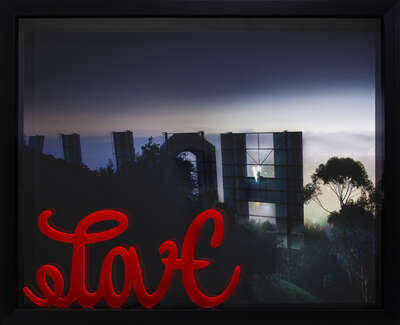Introduction
Internationally renowned artist Mia Florentine Weiss has already left her mark on cities across the globe. Her specially designed Love sculpture has stood proudly in front of the Brandenburg Gate (Berlin), in Washington, D.C., and in various prominent locations around the world. Weiss knows how to generate a response with her conceptual installations. This is also the case in her latest work. The artist utilizes the pull of emotion, focusing on a famous metropolis whose spectrum of associated feelings is unique: Hollywood. Set in a 3-D frame, her use of imagery and distinctive lettering results in a game of wordplay. The script Love says it all; When rotated 180 degrees, it transforms into an equally strong expression with paradoxical meaning: Hate. This typographic manipulation is known as an ambigram. Hollywood, a cinematographic dream factory, is well-suited for an artistic endeavor of this sort. As we look out from behind a historical California landmark, we see where Weiss has installed her sculpture. The message is simultaneously straightforward and ambiguous.
The photograph, which – together with the ambigram – establishes a compelling narrative, is a result of daring action. Weiss scaled the H of the legendary Hollywood sign, posing as an angel above the City of Angels. Her wings shine brightly in the night as she perches above the sleeping yet vibrant metropolis. This bold and ethereal performance creates polarity reminiscent of Rilke, who succinctly articulated the inherent dichotomies of angels.
Ambigrams have a long and fascinating history. Variations of this typeface style date as far back as Roman Pompeii. In 1893, the graphic ambigram was brought to life as an art form by the American artist and writer Peter Newell. Since then, well-known artists and writers have adopted this method of representation time and time again.
Mia Florentine Weiss' work addresses the extremes of human emotion. Her LOVE HATE ambigram was a key component of the 2017 Faust Festival in Munich. Not only did it address the two most prominent emotions in Goethe’s Faust, but it also conveyed a powerful sentiment to mark the 100th anniversary of the end of the first World War. Beyond this, however, the artist regularly broaches difficult, emotionally charged topics to spark controversial discussions. Immigration within Europe and across continental borders is an important subject for her – and one she frequently incorporates into her work. Weiss’ creations convey powerful messages and are often exhibited in the vicinity of state institutions.




